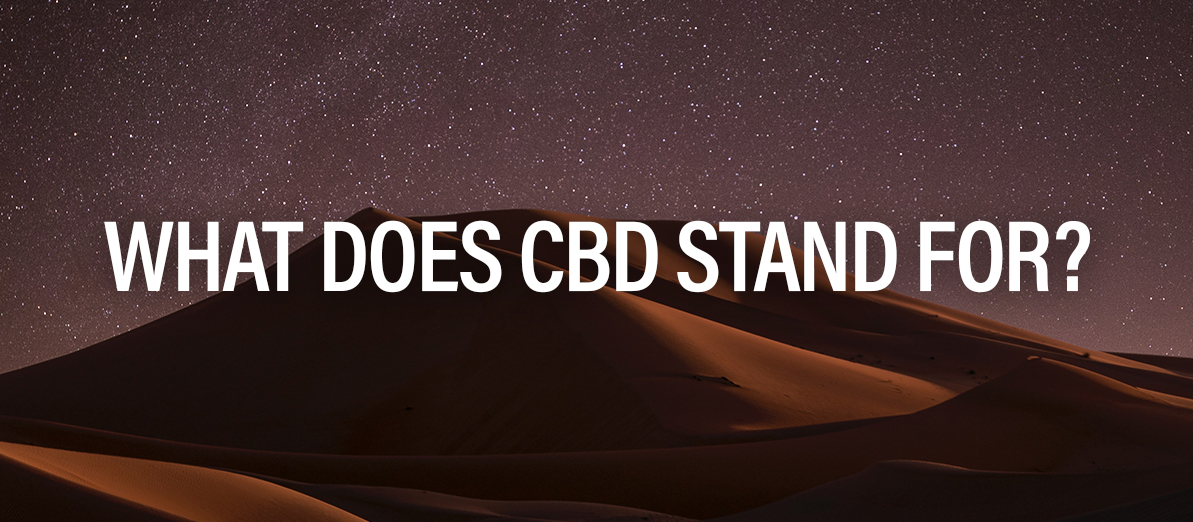CBD is one of the most widely used health and wellness products out there, but despite its popularity, many people find themselves wondering “What does CBD stand for”?
Humans have embraced hemp for over 10,000 years. Not only does this plant offer incredibly durable fibers for textile purposes, it’s also rich in a variety of beneficial compounds called “cannabinoids’ ‘.
THC is arguably the best-known of these cannabinoids due to its presence in Marijuana, but CBD has quickly become a household name. What is CBD? What do the letters “CBD” stand for? Let’s take a closer look and find out!
What are Cannabinoids and Phytocannabinoids?
Cannabinoids are defined as “the terpenophenolic constituents of Cannabis sativa L”. These powerful compounds exist in both plants and animals and are broken down into 2 respective categories.
Endocannabinoids exist in mammals, and phytocannabinoids exist in plants. While some scientists believe that there is a possibility of discovering phytocannabinoids outside the Cannabis family, there has not been any documentation of such findings to date.
Phytocannabinoids and endocannabinoids are complimentary by nature, and have the ability to produce desirable results when they interact with each other.
An Introduction to the Endocannabinoid System
CBD provides a wealth of benefits, and many people utilize this compound as a way to combat chronic pain, sleeplessness, or stay on top of their general wellness.
It’s widely accepted that CBD is a compound with great potential to combat certain ailments, and it does so through its interaction with the endocannabinoid system.
The endocannabinoid system is a complex series of retro-grade neurotransmitters that exist in mammals. This system contains cannabinoid receptors that are referred to as CB1 and CB2.
The CB1 receptor can be found in the brain, as well as other soft-tissues throughout the body, and influences the central nervous system. The CB2 receptors are abundant in cells of the macrophage lineage and primarily influence the peripheral nervous system.
Where Does CBD Come From?
CBD is an abbreviation for the word “Cannabidiol”. This compound is found in various types of cannabis, but present in high concentrations in the hemp plant.
Though it’s sometimes disputed, scientists believe there are three primary species of cannabis; Cannabis Ruderalis, Cannabis Sativa, and Cannabis Indica. Each of these species have similar chemical compositions, but in different concentrations.
Hemp is of the cannabis sativa family and has very high concentrations of Cannabidiol. CBD products contain cannabidiol that has been extracted from hemp using one of several types of extraction methods. Ethanol and CO2 are two extraction methods that are considered the most efficient at transferring cannabidiol from the raw hemp to the resulting extract oil.
What is Cannabidiol
Ok, so we know that cannabidiol is a compound that comes from the hemp plant, but what is it exactly?
Cannabidiol is a phytocannabinoid whose molecular structure is composed of 21 atoms of Carbon, 30 hydrogen atoms, and 2 oxygen atoms. This molecule has a mass of 314.464 g/mol. C21H30O2 happens to be the same molecular composition of THC, so how do these compounds differ?
CBD is a negative allosteric modulator of the CB1 receptor and THC is a powerful partial agonist of the CB1 receptor. To further understand what this means, let’s take a look at how CBD interacts with the endocannabinoid system.
CBD and the Endocannabinoid system
The endocannabinoid system can have powerful effects on the body, and is recognized for its ability to promote homeostasis. The body functions its best when its internal mechanisms are well-balanced, and phytocannabinoids can help stimulate the endocannabinoid system and influence it to maintain this balance.
When you consume cannabidiol, it is absorbed into the body in one of three ways; Inhalation, oral consumption, or transdermal absorption. Each one of these delivery methods has its own set of pros and cons that affect the amount of CBD that actually reaches the endocannabinoid system. Let’s take a look at what happens when you consume CBD orally.
When using a CBD tincture, it’s common practice to take a dropper-full of oil, place it under your tongue, and swish it around before swallowing. When you swish the oil around, it creates nano-emulsions that create a larger surface-area exposure and makes the CBD more easily absorbed.
Once the CBD is swallowed, it makes its way through your digestive system and starts to interact with the endocannabinoid system.
CBD indirectly interfaces with both the CB1 and CB2 receptors. While this interaction is still fairly mysterious to scientists, the results are easy to see.
Cannabidiols interaction with the endocannabinoid system has been shown to help with a variety of ailments including inflammation, sleeplessness, and most notably, seizures.
CBD is an abbreviation for cannabidiol, but it really stands for so much more.
When you’re ready to find out what CBD truly stands for
Click Here to check out our full selection of impressive CBD oils!



